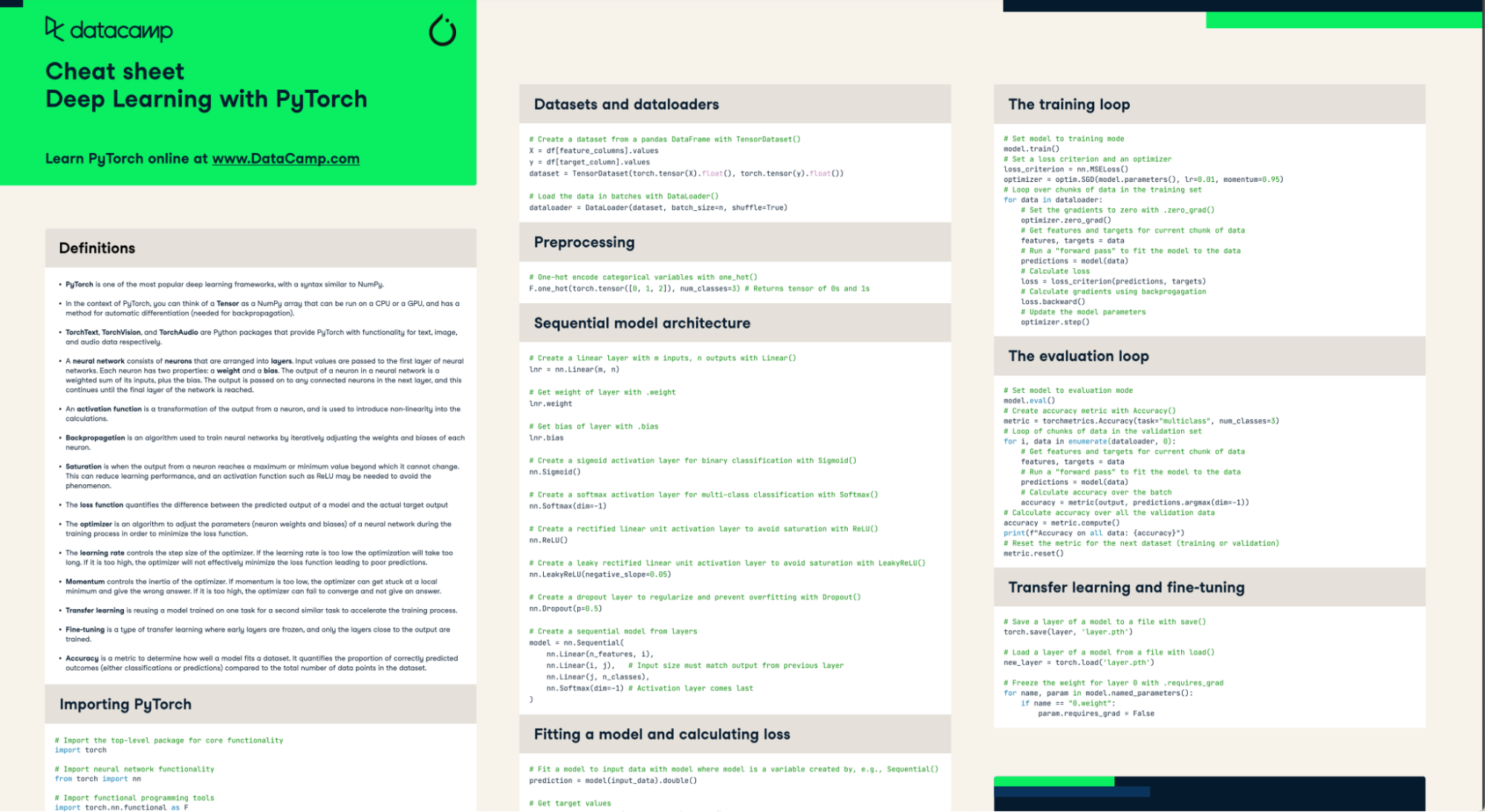Course
Deep learning is a transformative part of artificial intelligence (AI), helping to drive innovations from autonomous vehicles to advanced language models like GPT-4. This article aims to outline a structured pathway for how to learn deep learning and eventually master it. While deep learning represents a more specialized skill set within AI, it builds upon foundational machine learning & AI concepts. Therefore if you’re completely new to deep learning, we highly recommend you start with our guides on How to Learn Machine Learning or How to Learn AI instead.
What is Deep Learning?
Deep learning is a cutting-edge subset of machine learning that mimics the workings of the human brain in processing data and creating patterns for use in decision-making. It's a key technology behind many advanced applications, such as natural language processing, computer vision, and speech recognition, enabling machines to perform complex tasks without explicit programming. By leveraging neural networks with many layers, deep learning models can analyze large volumes of data, learning intricate structures and patterns, making it a powerful tool for AI development.
Popular Deep Learning Use-Cases
Deep learning technology powers many applications that impact our daily lives and industries. Here are some notable examples:
- Image and Video Recognition: Deep learning algorithms excel at recognizing patterns and objects within images and videos, enabling functionalities like facial recognition and autonomous vehicle navigation.
- Natural Language Processing (NLP): This involves understanding and generating human language and facilitating technologies like language translation services, chatbots, and virtual assistants. ChatGPT, for example, is built on top of deep learning algorithms.
- Finance: In the finance sector, deep learning is used for fraud detection, algorithmic trading, and risk management.
- Voice Recognition and Generation: These systems understand and generate human speech, powering voice-activated assistants and enabling real-time language translation.
Why Learn Deep Learning In 2026?
Whether you are a newcomer or already have some experience, there are many reasons to learn deep learning. Here are three reasons why:
- Job demand: The demand for machine learning roles is soaring, with deep learning skills being highly sought after. This expertise is crucial for cutting-edge AI projects and innovations. Companies across various industries are investing heavily in AI, making deep learning a valuable skill set for career advancement.
- Attractive Salaries: Deep learning roles are among the highest-paid in the tech industry, reflecting the advanced skill set and expertise required. For instance, the average salary for a deep learning engineer in the United States can range significantly, with figures like $146K per year as a median and potential total compensation reaching upwards of $181K, illustrating the lucrative nature of specializing in this field.
- Intellectual challenge: The continuous advancements in deep learning algorithms and computational power make it an exciting time to delve into this field, offering the potential to work on transformative technologies and contribute to future breakthroughs.

How Long Does It Take to Learn Deep Learning?
The journey to mastering deep learning varies greatly based on your background, dedication, and the learning resources you utilize. If you are a complete beginner, we highly recommend you start with machine learning instead, as it is a foundational piece of learning deep learning. For that, check out our guide on how to learn machine learning.
For those already comfortable with machine learning, delving into deep learning could take approximately 3 to 4 months to achieve proficiency. This estimate assumes a consistent learning schedule and practical application of skills through projects. However, deep learning is a vast and rapidly evolving field, so continued learning and adaptation are key to staying current.
How to Learn Deep Learning in 2026
Embarking on the journey to learn deep learning requires a strategic approach, blending theoretical knowledge with practical application. Here are 3 steps you can take to learn deep learning in 2026.
1. Brush up on the prerequisites
Before diving into deep learning, ensuring a strong foundation in the following areas is crucial:
- Basic Statistics & Mathematics: Understanding probability, statistics, linear algebra, and calculus is essential for grasping the underlying principles of deep learning algorithms.
- Data Structures & Manipulation: Proficiency in handling and processing data is vital, as deep learning involves working with large datasets.
- Machine Learning Theory & Applications: A solid grasp of machine learning concepts, including supervised and unsupervised learning, is necessary before tackling deep learning complexities.
If you are completely new to machine learning and AI, take your time focusing on these prerequisites, and take advantage of our guide on How to learn machine learning. With that said, here are some resources to help you brush up:
- Statistics Fundamentals with Python Skill Track
- Introduction to Data Structures and Algorithms Course
- Machine Learning Fundamentals with Python Skill Track
2. Develop Your Deep Learning Skills
Deep learning is an interdisciplinary field that requires a confluence of skills from various domains. Here's how each skill specifically relates to deep learning and some top resources for each:
Statistics
Understanding statistics is crucial in deep learning for interpreting data, understanding the behavior of algorithms under various conditions, and making informed decisions about model architecture and parameters.
Top resources to get up to speed:
- Statistics Fundamentals with Python Skill Track
- Introduction to Statistics Course
- Data Demystified: An Overview of Descriptive Statistics
Mathematics
Deep learning models, especially neural networks, are grounded in mathematical concepts such as linear algebra, calculus, and optimization. A strong grasp of these areas enables the development and understanding of complex models.
Top resources to get up to speed:
Programming
Programming, particularly in languages like Python, is essential for implementing and experimenting with deep learning models. Libraries such as TensorFlow and PyTorch abstract much of the complex mathematics, making programming a crucial skill.
Top resources to get up to speed:
- Python Programming Skill Track
- R Programming Skill Track
- Introduction to Programming Paradigms Course
Deep Learning Theory
A deep understanding of the theory behind deep learning, including the workings of various neural network architectures, is essential for designing effective models and understanding how they learn from data.
Top resources to get up to speed:
- Introduction to Deep Learning in Python Course
- Introduction to Deep Learning with Keras Course
- Introduction to Deep Learning in PyTorch Course
Deep Learning Application
Applying deep learning to real-world problems requires not only theoretical knowledge but also the ability to preprocess data, choose the right model architecture, train models efficiently, and evaluate their performance.
Top resources to get up to speed:
- Intermediate Deep Learning with PyTorch Course
- Advanced Deep Learning with Keras Course
- Introduction to Deep Neural Networks Tutorial
- Keras Tutorial: Deep Learning in Python
3. Learn Essential Deep Learning Tools & Packages
Mastering deep learning also involves getting comfortable with various tools and packages that facilitate model building, training, and deployment. Here's a closer look at each:
Tensorflow
TensorFlow is a comprehensive, open-source framework for machine learning and deep learning developed by Google. It's known for its flexibility in designing and training complex neural networks, with extensive support for various deep learning applications.
Top resources to get up to speed:
- Introduction to TensorFlow in Python Course
- TensorFlow Tutorial For Beginners
- Python Convolutional Neural Networks (CNN) with TensorFlow Tutorial
Keras
Keras serves as a high-level neural networks API, written in Python, and capable of running on top of TensorFlow, Theano, or Microsoft Cognitive Toolkit (CNTK). It's designed for easy and fast prototyping of deep learning models, emphasizing user-friendliness and modularity.
Top resources to get up to speed:
- Introduction to Deep Learning with Keras Course
- Advanced Deep Learning with Keras Course
- Keras Tutorial: Deep Learning in Python
PyTorch
PyTorch, developed by Facebook's AI Research lab, is favored for its dynamic computational graph and efficient memory usage, making it particularly useful for projects involving complex neural networks like RNNs and CNNs.
Top resources to get up to speed:
- Introduction to Deep Learning in PyTorch Course
- Intermediate Deep Learning with PyTorch Course
- PyTorch Tutorial: Building a Simple Neural Network From Scratch
- Deep Learning with PyTorch Cheat Sheet
MXNet
Apache MXNet is a deep learning framework designed for both efficiency and flexibility. It allows you to mix symbolic and imperative programming to maximize efficiency and productivity in model development.
Top resources to get up to speed:
Caffe2
Caffe2 is a lightweight, modular, and scalable deep learning framework. Developed by Facebook, it provides an easy and straightforward way for entrepreneurs and developers to deploy deep learning solutions on various platforms with minimal overhead.
An Example of a Deep Learning Learning Plan
For those already familiar with machine learning concepts, this deep learning learning plan is designed to further advance your skills in this specialized area. If you're starting from scratch or need a more foundational understanding of machine learning first, we recommend referring to our "How to Learn Machine Learning" guide to build a solid groundwork before diving into deep learning.
Months 1 to 2: Sharpen Your Maths & Statistics & Deep Learning Theory
Begin by enhancing your mathematical skills and deepening your theoretical understanding of deep learning. This period is essential for comprehending the intricacies of deep learning models and algorithms. Focus especially on the understanding the following:
- Linear Algebra: Understand matrices, vectors, eigenvalues, and eigenvectors, as they are fundamental in representing and manipulating data in deep learning.
- Calculus: Focus on differential and integral calculus, particularly partial derivatives and integrals, which are essential for understanding optimization in neural networks.
- Probability and Statistics: Grasp concepts such as probability distributions, statistical significance, and Bayesian thinking, crucial for model inference and decision-making.
- Optimization Techniques: Learn about gradient descent, stochastic gradient descent, and other optimization algorithms that are central to training deep learning models.
- Neural Network Architectures: Familiarize yourself with the basics of neural networks, including feedforward, convolutional, and recurrent neural networks, to understand how different architectures are applied to various problems.
Learning resources we recommend:
- Statistics Fundamentals with Python Skill Track
- Linear Algebra for Data Science in R Course
- Demystifying Mathematical Concepts for Deep Learning Tutorial
- Mastering Bayesian Optimization in Data Science Tutorial
- Introduction to Deep Neural Networks Tutorial

Our Deep Learning with PyTorch cheat sheet can help you learn deep learning
Months 3 to 6: Sharpen Your Maths & Statistics & Deep Learning Theory
After solidifying your foundation in the first two months, the next step in your deep learning journey is to choose a specialization. Diving into a specific domain allows you to apply deep learning more effectively to real-world problems and innovations. Consider focusing on one of the following areas:
- Natural Language Processing (NLP): Explore techniques for text analysis, sentiment analysis, language translation, and chatbot development. NLP applications are vast, from improving customer service to developing sophisticated AI assistants.
- Computer Vision: Delve into image recognition, object detection, and image generation tasks. Computer vision has transformative applications in security, healthcare, and autonomous vehicles.
- Speech Recognition: Work on translating spoken language into text, understanding the nuances of human speech, and developing voice-activated systems. This area is crucial for developing accessible technologies and enhancing user interfaces.
- Generative Models: Learn about generative adversarial networks (GANs) and variational autoencoders (VAEs) for tasks like image generation, style transfer, and more. Generative models open up creative possibilities in art, design, and entertainment.
- Reinforcement Learning: Study the principles of agents learning to make decisions through trial and error, applicable in game AI, robotics, and optimization problems.
Learning resources we recommend:
- Natural Language Processing in Python
- Image Processing with Python
- 7 NLP Projects for All Levels
- Generative AI for Business Course
- Introduction to Reinforcement Learning Tutorial
Top 5 Tips for Learning Deep Learning
As you embark on your deep learning journey, consider these essential tips to optimize your learning experience and achieve mastery more efficiently:
1. Don’t get bogged down by the maths
While a strong mathematical foundation is crucial, it's important not to get overwhelmed. Focus on understanding the concepts and their applications in deep learning models rather than getting lost in complex calculations.
2. Apply your skills to projects
Theoretical knowledge is vital, but applying what you've learned to real-world projects will solidify your understanding and skills. Projects also provide tangible outcomes that can be showcased to potential employers or collaborators. Check out our list of machine learning projects for some inspiration.
3. Balance practical work with reading papers
Staying updated with the latest research by reading papers is important, but it's equally crucial to balance this with practical work. Implementing concepts from papers in your projects can provide deep insights and enhance your learning. Moreover, don’t be overwhelmed if you first struggle with reading papers, it’s a skill that you will pick up the more you do it!
4. Join a community
Being part of a community can provide support, motivation, and new perspectives. Engage in forums, attend workshops or meetups, and collaborate with peers to enrich your learning experience.
5. Keep iterating
Deep learning is a rapidly evolving field, and continuous learning is key. Don't be afraid to revisit fundamentals or explore new areas as the field progresses. Iterative learning will keep your skills sharp and relevant.
The Best Resources to Learn Deep Learning in 2026
Deep learning is a rapidly evolving field, and staying updated with the best resources is crucial for effective learning. Whether you're a professional with machine learning experience or someone looking to dive deeper into deep learning, here are the top resources to consider:
Top deep learning courses to get started
- Introduction to Deep Learning in Python Course
- Introduction to Deep Learning with Keras Course
- Introduction to Deep Learning in PyTorch Course
Complete deep learning projects
- 25 Machine Learning Projects for All Levels
- 5 Projects You Can Build with Generative AI Models (with examples)
- 20 Data Analytics Projects for All Levels
Read some of the best deep learning books
Read top deep learning papers
Remember, the key to learning AI is consistency and practice. Don't be afraid to start small and gradually work your way up to more complex concepts and projects. You'll be amazed at how much you can learn by dedicating just a little time each day to studying AI.
Closing notes
Embarking on the journey to learn deep learning is both challenging and rewarding. Leveraging the right resources and adopting a hands-on approach can significantly accelerate your learning curve. Remember, the field is continuously evolving, so maintaining a habit of lifelong learning is key to staying relevant and innovative in deep learning.
If you’re totally new to the subject, check out our Introduction to Deep Learning in Python course our or Keras Toolbox deep learning track.

Adel is a Data Science educator, speaker, and VP of Media at DataCamp. Adel has released various courses and live training on data analysis, machine learning, and data engineering. He is passionate about spreading data skills and data literacy throughout organizations and the intersection of technology and society. He has an MSc in Data Science and Business Analytics. In his free time, you can find him hanging out with his cat Louis.

